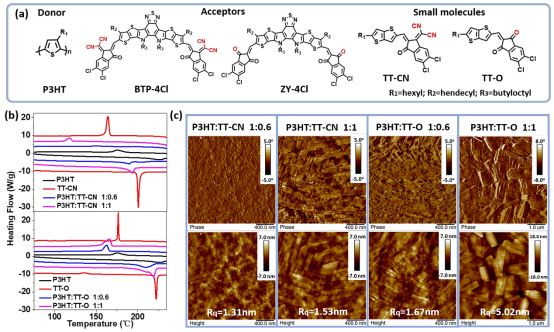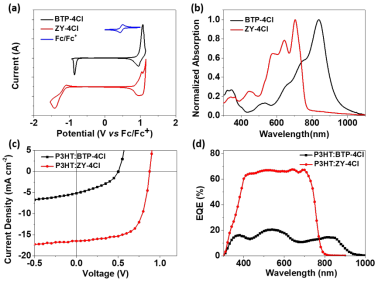IF: 30.289: Chenyi Yang (etc.) Molecular design of a non-fullerene acceptor enables a P3HT-based organic solar cell with 9.46% efficiency
IF: 30.289: Chenyi Yang (etc.) Molecular design of a non-fullerene acceptor enables a P3HT-based organic solar cell with 9.46% efficiency
Chenyi Yang, Shaoqing Zhang,* Junzhen Ren, Mengyuan Gao, Pengqing Bi, Long Ye* and Jianhui Hou*
Published: September 1, 2020 https://doi.org/10.1039/D0EE01763A
Abstract
The power conversion efficiencies (PCEs) of organic solar cells (OSCs) have exceeded 17-18% nowadays. However, most of the donor materials show complicated structures that require for tedious synthesis and purification procedure, which seriously hinder the industrialization of OSCs. Therefore, simplifying the chemical structure of donor materials to reduce the production cost is an urgent issue in the field of OSCs. Poly(3-hexylthiophene) (P3HT) has been regarded as one of the promising candidates for commercial OSCs for its availability in large quantities with low cost. However, the current PCEs of P3HT-based OSCs are still too low to meet the requirement of practice applications, and how to improve the PCE of P3HT-based OSCs remains a challenge. Herein, we designed and synthesized a new NFA, ZY-4Cl, by modifying the cyano-substituted end groups of the reported acceptor BTP-4Cl. Such a modification can effectively upshift the energy levels of the acceptor so that increase the open-circuit voltage of the corresponding device. More importantly, the calculated Flory-Huggins interaction parameter, DSC and AFM measurement results clearly indicate that the end group of ZY-4Cl, the one without cyano group, has lower miscibility with P3HT when compared with that of BTP-4Cl, resulting in the improved phase separation morphologies for P3HT:ZY-4Cl-based blend films, which contribute to the efficient charge transport and collection. As a result, a high PCE of 9.46% is achieved from P3HT:ZY-4Cl-based device, which is a new record for P3HT-based OSCs. Furthermore, the feasibility of this molecular design strategy is also verified in other NFAs, which suggests a guidance for the molecular design of NFAs from the aspect of morphology control.
Keywords: poly(3-hexylthiophene) | non-fullerene acceptors | end groups | phase separation | organic solar cells
Link:
Chenyi Yang, Shaoqing Zhang,* Junzhen Ren, Mengyuan Gao, Pengqing Bi, Long Ye* and Jianhui Hou*. (2020) Molecular design of a non-fullerene acceptor enables a P3HT-based organic solar cell with 9.46% efficiency. Energy Environ. Sci. DOI: 10.1039/d0ee01763a

Fig. 1 (a) Molecular structures of materials. (b) DSC curves of neat materials and blends at different weight ratios (Exo up). (c) AFM images of P3HT:TT-CN and P3HT:TT-O blends at different weight ratios (2×2 µm2, 5×5 µm2 for P3HT:TT-O = 1:1 film).

Fig. 2 (a) CV curves of BTP-4Cl and ZY-4Cl. (b) UV-vis absorption spectra of BTP-4Cl and ZY-4Cl in thin film state. (c) J-V and (d) EQE curves of BTP-4Cl- and ZY-4Cl-based devices.

